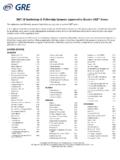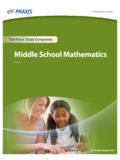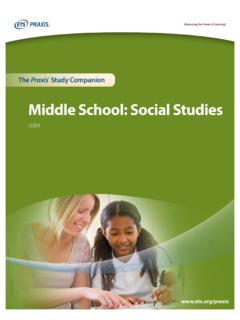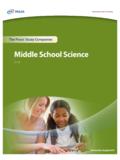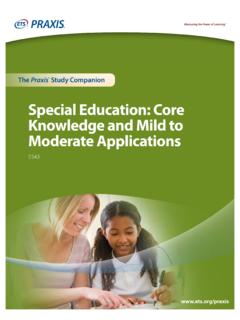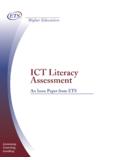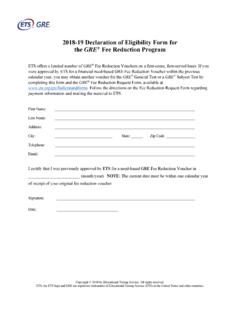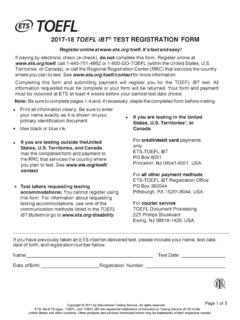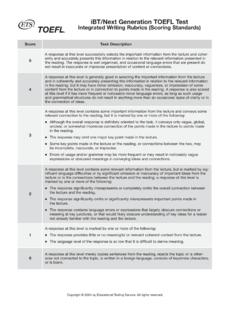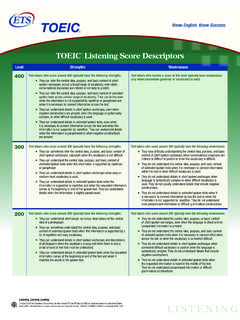Transcription of What is Quantitative Reasoning? Defining the …
1 Research & Development Carol Anne DwyerAnn Gallagher Jutta Levin Mary E. Morley ResearchReportNovember 2003 RR-03-30 what is Quantitative reasoning ? Defining the construct for Assessment Purposes what is Quantitative reasoning ? Defining the construct for Assessment Purposes Carol Anne Dwyer, Ann Gallagher, Jutta Levin, and Mary E. Morley Educational Testing Service, Princeton, NJ November 2003 Research Reports provide preliminary and limited dissemination of ETS research prior to publication. They are available without charge from: Research Publications Office Mail Stop 7-R Educational Testing Service Princeton, NJ 08541 i Abstract In order to create fair and valid assessments, it is necessary to be clear about what is to be measured and how the resulting data should be interpreted.
2 For a number of historical and practical reasons described in this paper, adequately detailed statements with both a theoretical and empirical base do not currently exist for the construct of Quantitative reasoning for use in assessments. There is also no adequate explanation of the important differences between assessments that measure Quantitative reasoning constructs and those that are intended to measure achievement in related mathematical content areas. The literature in psychology, psychometrics, philosophy, and education, while containing much that is relevant to the construct of Quantitative reasoning , unfortunately does not provide materials that can be used in research and development to address such practical issues or to explain the basic nature of Quantitative reasoning assessments.
3 This paper briefly discusses the importance and use of constructs and the Quantitative reasoning and standards literature. It then presents a statement about the construct of Quantitative reasoning for assessment purposes within a construct validity framework that includes both a definition of the construct and threats to valid score interpretation. These threats are based on related but distinguishable constructs and other types of construct -irrelevant variance in the assessments. Key words: Assessment, Quantitative reasoning , constructs, validity, fairness, construct validity theory ii Table of Contents Page 1 1 Nature of the Quantitative reasoning construct 3 Constructs and Individual Measures .. 3 Historical Development of reasoning Theory and Assessments.
4 4 The Development of Quantitative reasoning Constructs and Assessments .. 7 Definition of Quantitative reasoning construct for Assessment 12 Outline of the Components of the Problem-solving Process .. 14 Mathematics Content Issues .. 15 Mathematics Content Categories Used in Quantitative reasoning 17 Considerations in Measuring Quantitative reasoning : Threats to Validity .. 19 The Role of Calculation in Assessment .. 19 Issues Related to Spatial and Visual Abilities .. 20 Reading Load and Quantitative 21 Speed of Responding ..22 Descriptive Materials for Tests .. 24 Descriptions of Quantitative reasoning .. 25 Descriptions of Mathematics Content Necessary for Quantitative reasoning .. 26 Test Preparation .. 27 Comparisons Among Quantitative reasoning Tests.
5 28 Content Categories and Their Distribution .. 30 Question Contexts .. 31 Question Types .. 32 Summary and Conclusions .. 35 37 Notes .. 43 Appendix: Sample 45 1 Overview Purpose The intention of this paper is to describe Quantitative reasoning in a comprehensive way within the framework of construct validity theory and to give several examples of how selected testing programs have operationalized this construct in the assessments they offer. Where the appropriate information is available, we will also compare and contrast the approaches taken by these assessments and give rationales for the differences. This construct -validity framework requires that the construct that will form the basis of an assessment must be clearly specified, as well as differentiated from similar but distinct constructs and from other nonconstruct influences that may disrupt score interpretation.
6 Thus for assessment purposes, having a clear construct definition is essential to validity and fairness and to the scientific integrity of the inferences drawn from the assessments. It is also a practical aid to decision-making about assessment design, development, and interpretation and provides a common framework for discussion among those involved in the assessments in various roles. The Quantitative reasoning literature is extensive, and interdisciplinary professional consensus on the nature and extent of Quantitative reasoning has become very strong. This consensus is captured in detail in standards developed by the National Council of Teachers of Mathematics (NCTM) (National Council of Teachers of Mathematics [NCTM], 2000) and by other related sets of standards for all educational levels that cover both mathematical content and Quantitative reasoning .
7 The NCTM Quantitative reasoning standards are broader in scope than can be captured in an assessment setting, as they encompass such elements as the creation of new mathematical knowledge. According to the NCTM, Quantitative reasoning is the developed ability to analyze Quantitative information and to determine which skills and procedures can be applied to a particular problem to arrive at a solution. Quantitative reasoning , both generally and for assessment purposes, has an essential problem-solving focus. It includes the following six capabilities: reading and understanding information given in various formats; interpreting Quantitative information and drawing inferences from it; solving problems using arithmetic, algebraic, geometric, or statistical methods; estimating answers and checking for 2 reasonableness; communicating Quantitative information; and recognizing the limitations of mathematical or statistical methods.
8 A detailed description of the Quantitative reasoning problem-solving process is presented. Quantitative reasoning requires the use of mathematical content for assessment purposes and for problem solving more generally. Quantitative reasoning is, however, fundamentally different, both conceptually and practically, from mathematical content knowledge. It is dependent upon, rather than psychologically prior to, this other form of valuable expertise. Being clear about the differences between Quantitative reasoning and mathematical content knowledge relates closely to the fairness and validity of assessments. Thus it is critical to specify for any Quantitative reasoning assessment what mathematical content knowledge is required to address the problem-solving tasks represented in the assessment.
9 Four other important potential threats to the validity of assessments of Quantitative reasoning discussed in this paper are calculation load, visual and spatial components, speed of responding, and reading load. To illustrate different approaches to operationalizing the construct of Quantitative reasoning , major ETS tests that contain a Quantitative reasoning measure were compared and contrasted with respect to their measurement of Quantitative reasoning , inclusion of mathematical content, and published statements that define a construct of Quantitative reasoning for their assessment purposes. Although the target construct of Quantitative reasoning appears to be highly similar among the tests we reviewed, specific variations with respect to test content and format do exist and seem related to such factors as differences in program purposes and populations.
10 We conclude that a more comprehensive construct -centered approach is needed in order to link the assessment s core concept to the actual content of the test and the type of reasoning it assesses. Quantitative reasoning for assessment purposes is a problem-solving process with identifiable steps, some of which can be measured by standardized tests. Quantitative reasoning is not the same as mathematical content knowledge, but knowledge of mathematical content is necessary (although not sufficient) to solve Quantitative reasoning problems. The authors of this paper aim to create a shared understanding of both the nature of constructs and of Quantitative reasoning that will help guide future discussion and decision-making for research, development, and operational purposes.
